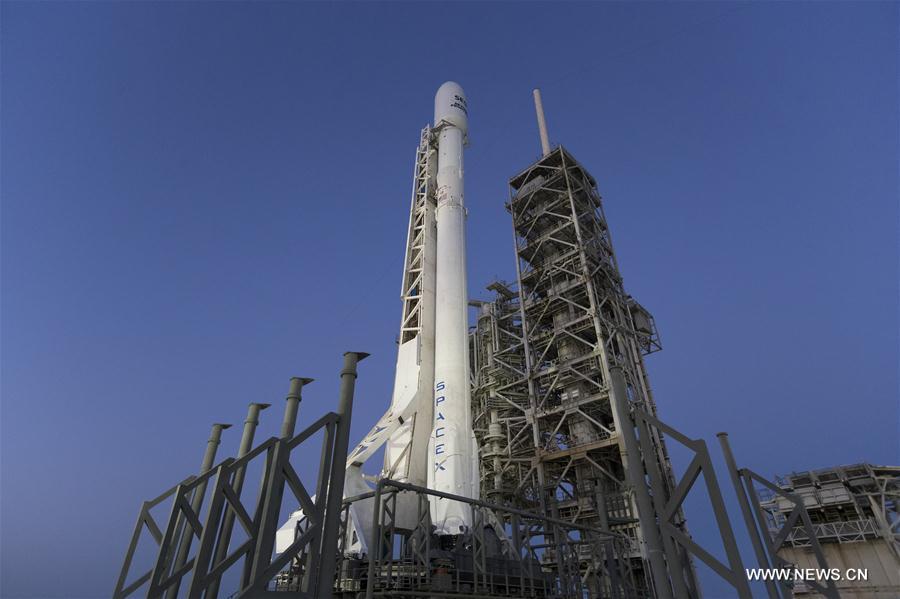

 |
| The photo made available by U.S. space firm SpaceX on March 30, 2017 shows the company's Falcon 9 rocket at the Kennedy Space Center in Florida, the United States. (Xinhua) |
WASHINGTON, March 30 (Xinhua) -- U.S. space firm SpaceX made history on Thursday as it launched an already-used Falcon 9 rocket back into space for the first time and then landed its first stage on a droneship in the Atlantic Ocean.
The two-stage rocket, carrying a communications satellite into orbit for Luxembourg-based satellite operator SES, blasted off at 6:27 p.m. EDT (22:27 GMT) from the Kennedy Space Center in Florida.
About 10 minutes later, the first stage, or booster, achieved a successful landing on the "Of Course I Still Love You" droneship that was stationed in the Atlantic Ocean.
"We just had an incredible day today," SpaceX CEO Elon Musk said during a live webcast of the launch. "The first reflight of an orbital class booster did its mission perfectly, dropped off the second stage, came back and landed on the droneship, right in the bullseye."
Elon said the feat means it can fly and refly an orbital class booster, which is the most expensive part of the rocket.
"This is going to be ultimately a huge revolution in spaceflight," Musk continued. "It's the difference between if you had airplanes where you threw away an airplane after every flight versus you could reuse them multiple times.
Previously, the first stage of the rocket for the SES-10 mission flew in a cargo resupply mission to the International Space Station cargo for the the U.S. space agency NASA in April 2016.
SpaceX achieved a space industry first in December 2015 when its Falcon 9 rocket booster successfully landed upright on solid ground at Cape Canaveral, Florida, after launching 11 small satellites into orbit.
The feat has since been repeated both on land and at sea for multiple times.
SpaceX's rival firm, Blue Origin, owned by Amazon founder Jeff Bezos, successfully completed similar rocket recovery tests, but all of its missions were suborbital, not orbital, ones.
All these attempts were aimed at producing a fully and rapidly reusable rocket, which allegedly will dramatically reduce the cost of space transport.
Traditionally, rockets are designed for a single use only, burning up or crashing into the ocean after liftoff.
Falcon 9's second stage, which currently still is expendable or single use, also succeeded in its mission to send the SES-10 satellite to a geostationary transfer orbit.
Once in position, the satellite will provide telecommunications services to Latin America.
SES has been known to be "a strong supporter" of SpaceX's approach to reusability over the years. Back in 2013, it was the first company to launch a commercial satellite on a Falcon 9 rocket.
The European satellite operator hailed Thursday's launch as "one step closer to rapid rocket reusability" and "one step closer to faster, easier access to space."
"Reusable rockets will not only drive down the launch cost," it said in a statement. "They will also allow a higher launch frequency, which will definitely bring a new agility and competitive edge to the satellite industry."

 Award-winning photos show poverty reduction achievements in NE China's Jilin province
Award-winning photos show poverty reduction achievements in NE China's Jilin province People dance to greet advent of New Year in Ameiqituo Town, Guizhou
People dance to greet advent of New Year in Ameiqituo Town, Guizhou Fire brigade in Shanghai holds group wedding
Fire brigade in Shanghai holds group wedding Tourists enjoy ice sculptures in Datan Town, north China
Tourists enjoy ice sculptures in Datan Town, north China Sunset scenery of Dayan Pagoda in Xi'an
Sunset scenery of Dayan Pagoda in Xi'an Tourists have fun at scenic spot in Nanlong Town, NW China
Tourists have fun at scenic spot in Nanlong Town, NW China Harbin attracts tourists by making best use of ice in winter
Harbin attracts tourists by making best use of ice in winter In pics: FIS Alpine Ski Women's World Cup Slalom
In pics: FIS Alpine Ski Women's World Cup Slalom Black-necked cranes rest at reservoir in Lhunzhub County, Lhasa
Black-necked cranes rest at reservoir in Lhunzhub County, Lhasa China's FAST telescope will be available to foreign scientists in April
China's FAST telescope will be available to foreign scientists in April